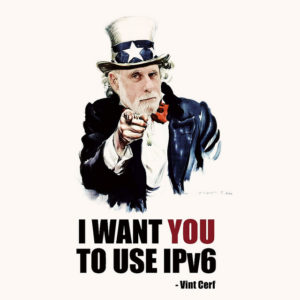 One of the messages that was clear at this year’s North American IPv6 Summit is that Dual-Stack is only halfway there. We don’t really want to maintain two networks (IPv4 and IPv6) forever. We want to get to IPv6-Only networks.
One of the messages that was clear at this year’s North American IPv6 Summit is that Dual-Stack is only halfway there. We don’t really want to maintain two networks (IPv4 and IPv6) forever. We want to get to IPv6-Only networks.
Moving to IPv6-Only
The good news is that major corporations, such as Cisco, Microsoft, and Comcast, are moving in this direction. With them in the lead, we don’t have to reinvent the wheel when transitioning our own networks for IPv6-Only.
However, another key message at the conference was that there will be a Long-Tail of IPv4 use. We don’t have the luxury of abandoning IPv4 just because it is simpler to manage a single protocol IPv6 network.
Transition: MAP-T
Therefore we need to create transition mechanisms which allow older IPv4-only devices to gain access to the legacy IPv4 Internet. One of the transitions mechanisms which has potential is MAP-T (Mapping of Address and Port using Translation). Think of MAP-T as IPv6 quasi-tunneling in reverse. Rather than how we have been stitching the IPv6 network together with tunnels over IPv4, it is the reverse, carrying IPv4 over an IPv6-Only network.
RFC 7599 explains in detail how MAP-T operates, but here are the highlights
- The CE uses stateless NAT64 creating an algorithmic IPv4-IPv6 address mapping codified as MAP Rules
- A MAP IPv6 address identifier MAP-T includes the IPv4 destination address and a 16 bit PSID (Port Set ID) in the last 64 bits (IID) of the IPv6 address.
- CE IPv4-IPv6 forwarding behavior where IPv6 packets arrive from the BR, and are subject to NAT44 and translated to the private address Dual-Stack network.
MAP is bit more complex in that a CE and BR are required than standard stateful NAT64. However, it utilized stateless NAT64, which is expected to scale better.
Trying it out in a Virtual Lab
OpenWrt/LEDE both have MAP-T CE packages, and you can start exploring this transition mechanism now. In fact, Cisco has a very nice KVM Lab page, running everything (CE, DHCPv6 server, BR) in VMs, where no hardware is required.
I still see stateful NAT64 being useful for smaller networks, but MAP-T takes great strides at solving the scale problems of NAT64. So start thinking about IPv6-Only network, it is closer than you think.
